Webb reveals never-before-seen details in Cassiopeia A
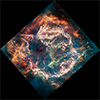 Glowing dust and elements display complex structures that are challenging for scientists to explain.
Glowing dust and elements display complex structures that are challenging for scientists to explain.
Apr 7th, 2023
Read more
 Subscribe to our Space Exploration News feed
Subscribe to our Space Exploration News feed
 Glowing dust and elements display complex structures that are challenging for scientists to explain.
Glowing dust and elements display complex structures that are challenging for scientists to explain.
Apr 7th, 2023
Read more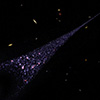 This supermassive black hole, weighing as much as 20 million Suns, has left behind a never-before-seen 200,000-light-year-long 'contrail' of newborn stars, twice the diameter of our Milky Way galaxy.
This supermassive black hole, weighing as much as 20 million Suns, has left behind a never-before-seen 200,000-light-year-long 'contrail' of newborn stars, twice the diameter of our Milky Way galaxy.
Apr 6th, 2023
Read more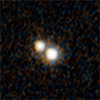 Astronomers have made an unexpected and rare discovery: a pair of gravitationally bound quasars, both blazing away inside two merging galaxies. They existed when the universe was just 3 billion years old.
Astronomers have made an unexpected and rare discovery: a pair of gravitationally bound quasars, both blazing away inside two merging galaxies. They existed when the universe was just 3 billion years old.
Apr 5th, 2023
Read more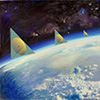 Lightweight flexible mirrors could be rolled up during launch and then precisely reshaped after deployment.
Lightweight flexible mirrors could be rolled up during launch and then precisely reshaped after deployment.
Apr 4th, 2023
Read more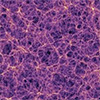 An international team of astrophysicists and cosmologists have submitted a set of five papers, measuring a value for the 'clumpiness' of the universe's dark matter, known to cosmologists as S8, of 0.76, which aligns with values that other gravitational lensing surveys have found in looking at the relatively recent universe - but it does not align with the value of 0.83 derived from the Cosmic Microwave Background.
An international team of astrophysicists and cosmologists have submitted a set of five papers, measuring a value for the 'clumpiness' of the universe's dark matter, known to cosmologists as S8, of 0.76, which aligns with values that other gravitational lensing surveys have found in looking at the relatively recent universe - but it does not align with the value of 0.83 derived from the Cosmic Microwave Background.
Apr 4th, 2023
Read more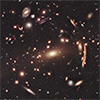 A new study probing the structure and evolution of galaxy clusters shows good agreement with the predictions of standard cosmological models.
A new study probing the structure and evolution of galaxy clusters shows good agreement with the predictions of standard cosmological models.
Apr 3rd, 2023
Read more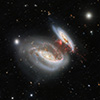 A head-on collision between the two galaxies UGC 12914 (left) and UGC 12915 (right) 25-30 million years ago appears to have resulted in a different kind of structure - a bridge of highly turbulent material spanning the two galaxies. Though this intergalactic bridge is teeming with star-forming material, its turbulent nature is suppressing star formation.
A head-on collision between the two galaxies UGC 12914 (left) and UGC 12915 (right) 25-30 million years ago appears to have resulted in a different kind of structure - a bridge of highly turbulent material spanning the two galaxies. Though this intergalactic bridge is teeming with star-forming material, its turbulent nature is suppressing star formation.
Mar 30th, 2023
Read more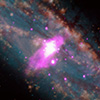 Much like how wind plays a key role in life on Earth by sweeping seeds, pollen and more from one place to another, galactic winds - high-powered streams of charged particles and gases - can change the chemical make-up of the host galaxies they form in, simply by blowing in a specific direction.
Much like how wind plays a key role in life on Earth by sweeping seeds, pollen and more from one place to another, galactic winds - high-powered streams of charged particles and gases - can change the chemical make-up of the host galaxies they form in, simply by blowing in a specific direction.
Mar 30th, 2023
Read more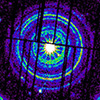 Astronomers have provided vital information in the global effort to understand the brightest-ever detected gamma ray burst, which swept through our Solar System in October last year.
Astronomers have provided vital information in the global effort to understand the brightest-ever detected gamma ray burst, which swept through our Solar System in October last year.
Mar 28th, 2023
Read more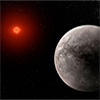 An international team of researchers has used the James Webb Space Telescope to measure the temperature of the rocky exoplanet TRAPPIST-1 b. The measurement is based on the planet's thermal emission: heat energy given off in the form of infrared light detected by Webb's Mid-Infrared Instrument (MIRI).
An international team of researchers has used the James Webb Space Telescope to measure the temperature of the rocky exoplanet TRAPPIST-1 b. The measurement is based on the planet's thermal emission: heat energy given off in the form of infrared light detected by Webb's Mid-Infrared Instrument (MIRI).
Mar 28th, 2023
Read more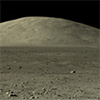 Scientists have discovered that impact glass beads present in the Chang'e-5 lunar soil samples contain water.
Scientists have discovered that impact glass beads present in the Chang'e-5 lunar soil samples contain water.
Mar 28th, 2023
Read more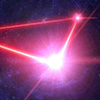 A new study proposes an array of interferometers in space to detect subtle fluctuations in the background gravitational signals that may reveal the secrets of black hole mergers.
A new study proposes an array of interferometers in space to detect subtle fluctuations in the background gravitational signals that may reveal the secrets of black hole mergers.
Mar 27th, 2023
Read more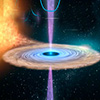 Researchers have found a neutron star that captures matter from a companion star in a violent and unstable process. This process, previously observed only in very bright black holes, opens the door to new insights into the behaviour of stars.
Researchers have found a neutron star that captures matter from a companion star in a violent and unstable process. This process, previously observed only in very bright black holes, opens the door to new insights into the behaviour of stars.
Mar 27th, 2023
Read more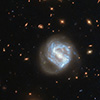 Astrophysicists have leveraged artificial intelligence to uncover a better way to estimate the mass of colossal clusters of galaxies. The AI discovered that by just adding a simple term to an existing equation, scientists can produce far better mass estimates than they previously had.
Astrophysicists have leveraged artificial intelligence to uncover a better way to estimate the mass of colossal clusters of galaxies. The AI discovered that by just adding a simple term to an existing equation, scientists can produce far better mass estimates than they previously had.
Mar 23rd, 2023
Read more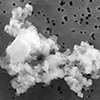 A proposed way to search for alien life using tiny rocks ejected from other worlds.
A proposed way to search for alien life using tiny rocks ejected from other worlds.
Mar 23rd, 2023
Read more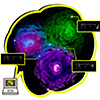 An international team has used artificial intelligence to analyze the chemical abundances of old stars and found indications that the very first stars in the Universe were born in groups rather than as isolated single stars.
An international team has used artificial intelligence to analyze the chemical abundances of old stars and found indications that the very first stars in the Universe were born in groups rather than as isolated single stars.
Mar 23rd, 2023
Read more Oumuamua, the first known interstellar object found moving through our solar system, may be propelled by hydrogen gas produced by ice reserves according to international researchers.
Oumuamua, the first known interstellar object found moving through our solar system, may be propelled by hydrogen gas produced by ice reserves according to international researchers.
Mar 22nd, 2023
Read more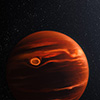 Weather report: Expect scattered, patchy clouds made up of silicates on planet VHS 1256 b.
Weather report: Expect scattered, patchy clouds made up of silicates on planet VHS 1256 b.
Mar 22nd, 2023
Read more